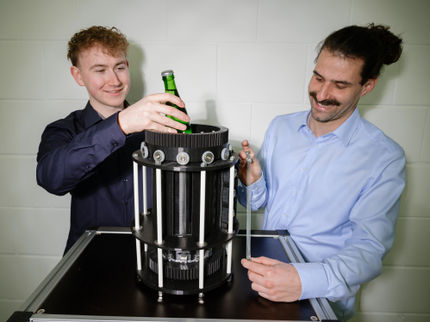Cooling with the sun
Can you cool with waste heat? Sure. A Swiss research project involving Empa, which ended in November, demonstrated this in an impressive way. Now a large-scale EU project is starting: industrial cooling – thanks to the Spanish sun.

Solar heat can cool industrial products. Empa is supporting a project in Spain.
Alexas_Fotos, pixabay.com, CC0
Every now and so often heating something up is unavoidable. Potato soup or risotto, tomato sauce or chocolate pudding – all unfeasible without heat. A small proportion of the heat ends up in the stomach, while the remaining majority (inadvertently) warms the surroundings. If we think outside the kitchen, we soon spot the next waste heat suspects: If our laptop gets that warm, just imagine how much more heat an internet provider’s server park must produce. We like to have hot showers and let the warm water go down the drain; it’s exactly the same story at the launderette around the corner. Then we head out the door and start our car: Its engine converts more than three quarters of the energy contained in gasoline into (waste) heat – and only the smaller proportion into the desired propulsion.
Thus far, all this thermal energy has been lost. This is now bound to change. A pan-European research consortium is starting to “collect” waste heat. A team from Empa is also on board.
Matthias Koebel first became interested in collecting heat through the THRIVE project (“Thermally driven adsorption heat pumps for substitution of electricity and fossil fuels”), a Swiss research project initiated by IBM Research Zurich. The lab in Rüschlikon asked itself a simple question: Can anything useful be done with the vast amount of waste heat from a large computer center? Is the energy perhaps sufficient to actively cool this data center? The IBM researchers called in a series of Swiss materials and systems specialist as partners: ETH Zurich, the University of Applied Sciences Rapperswil (HSR), the School of Business and Engineering Vaud (HEIG-VD), the Paul Scherrer Institute (PSI) – and Empa. The goal was to develop an adsorption heat pump that converts waste heat into cooling capacity.
Adsorption heat pumps use heat to generate cooling capabilities. In the plant’s cool zone, water evaporates and provides cooling. The water vapor is captured by an absorber material in the warm zone. Once the absorber material is saturated, it is dried again with heat from outside and is available for another cooling cycle.
Empa material triples cooling capacity
In November 2018, after 47 months in the making, the project drew to a successful close. Within the scope of THRIVE, the HSR researchers initially made a research heat pump with an output of 1 kW (kilowatts) and later a prototype of an adsorption heat pump that was ten times more powerful. This would be sufficient to air-condition a detached house in Southern Europe in the summer.
Adsorption heat pumps, however, are not just useful to cool individual houses or server parks; they could also improve the efficiency of district heating grids, as the researchers from HEIG-VD calculated. If in future they were to be used for the stationary heat supply, this would result in energy savings of four to nine percent, and another three to six percent in the industrial waste heat sector, according to calculations by PSI researchers. Koebel’s team succeeded in developing a new absorption material with a cooling output that is over three times higher than the initial material at the start of the project.
The Empa researchers are now looking to build on this newly developed material. “We developed a porous carbon sponge that is able to absorb a vast amount of water thanks to its micropores, which makes it just the ticket for adsorption heat pumps,” Koebel explains. The material is made from synthetic resin by way of pyrolysis. “This method enables us to tailor the material to the intended purpose.”
Customizable for any purpose
This means it will be possible to adapt adsorption heat pumps for different purposes in the future. For instance, a wood pellet heater generates higher temperatures than the flow of waste heat in a large kitchen. In order to convert the available heat into cooling capacity as efficiently as possible, the heat pumps’ absorber material needs to be tuned to the heat source and the desired cooling level. “We start by defining the suitable material based on material parameters and then manufacture it,” says Koebel.
Thanks to this expertise, the Empa team is now involved in a new EU research project called HyCool, which was launched in May 2018 and will run for three years. The goal: The aroma manufacturer Givaudan and the Spanish food producer Bo de Debò would like to cover their cooling needs for their production plants solely with the aid of waste heat and solar power. This will involve combining the absorption heat pump with a conventional one to produce what is known as a hybrid heat pump – which consumes additional electricity but is extremely flexible.
Solar cooling for Spanish ready meals
The heat required for cooling is to be generated on the roof of a Spanish factory near Barcelona. A 400-square-meter field of mirrors focuses sunlight onto a pipe, where water vapor is produced to provide the necessary cooling capacity via the absorption heat pump. In the same way, the factory receives process heat of up to 180 degrees Celsius and heat of up to 65 degrees for the hot water supply and to heat the factory in the wintertime.
We will still need to warm things up in the future. We just have to learn to be much more careful with the waste heat we produce. Saving fossil fuels also means avoiding wasting energy by making better use of waste heat at an industrial level.






























































